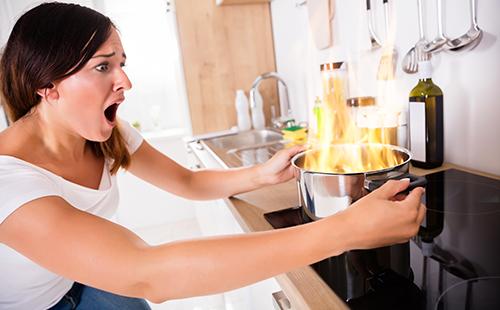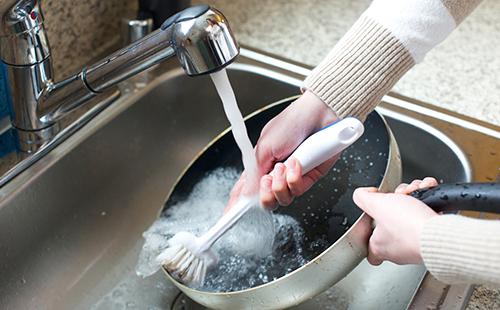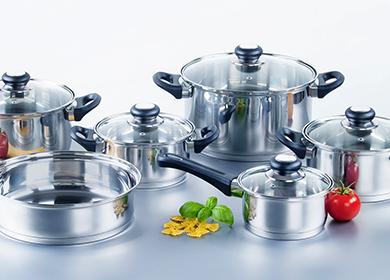The content of the article
- 1 Features steel
- 2 Complex pollution on a stainless steel
- 3 How to wash stainless steel dishes: an overview of folk ways
- 4 Carbon products for pots and pans
- 5 We fight limescale and scale in the kettle
- 6 We polish forks, spoons and knives, remove blackness
- 7 6 rules of care and prevention
- 8 “To look like a mirror”: reviews and experience of the hostesses
Despite the fact that the invention of steel with the addition of chromium and nickel belongs to the British, it was the French, the legislators of world culinary, who first used this metal for making dishes. After them, the baton was intercepted by Italians - artisans who not only modernized the technology of tableware, but also significantly expanded the range of cutlery and kitchen utensils. In the production of modern cook tools and serving items, the most advanced technologies are used, which have stepped far ahead of their predecessors. Over time, all housewives ask themselves: how to clean old dishes and white plates from rust?
Features steel
The dishes have darkened - it’s not a problem! A stainless article is called any kind of iron-carbon alloy with the addition of chromium, which somehow creates a protective, self-renewing anti-corrosion film on the metal surface. For the manufacture of tableware, high-quality chrome-nickel steel alloy marking X18H10 (8/10) is used. Such steel is distinguished by high safety and durability indicators, due to which, with proper care even after decades, the dishes from it will retain not only a radiant appearance, but will also be environmentally friendly and safe for cooking.
Today, the range and scale of production of steel chrome-nickel ware is incredibly extensive, thanks to its positive distinctive qualities. Four of them can be distinguished.
- Heat resistance. Steel 18/10 retains its nominal qualities in a rather large temperature range. This allows you to use such dishes equally effectively and at negative values, for example, in the freezer, and at high temperatures in the oven.
- Wear resistance. Steel alloy is one of the most durable and tough. Such dishes are resistant to deformation, scratches, chips and other mechanical damage, which is very important in everyday life. Steel pots and pans can be used for cooking on different types of stoves: gas, induction, glass-ceramic.
- Corrosion Resistance. High resistance to moisture, acids and alkalis makes steel an ideal choice for making dishes, because it is kitchen utensils that are most exposed to the aggressive influence of food acids, detergents and liquids.
- Hygiene. The high density of metal and polishing stainless dishes to a mirror shine makes it resistant to the accumulation and spread of harmful microorganisms.In addition, in the course of numerous studies, the bacteriostatic properties of steel were proved, that is, its ability to inhibit the development of pathogenic microbes.
Steel dishes also have features depending on the method of surface treatment:
- polished products - keep warm longer and are more hygienic;
- matte products - more resistant to mechanical damage.
Complex pollution on a stainless steel
How to wash the dishes outside? Despite the fact that steel utensils are particularly resistant to external influences, various defects and contaminants may appear on its surface during operation. This is a consequence of the negative impact of an aggressive environment. What are you talking about?
- Mineral salts and scale. Even after the first boiling of water, spot spots may appear in the steel pan. And this is not a marriage of utensils at all, but a chemical reaction of a metal to contact with impurities located in tap water. Often ordinary tap water can contain not only chlorine, but also oxidized and dissolved minerals, such as Fe, Cr, Na, K, Mn. The concentration of impurities may vary depending on the technology of water treatment and the region of the country. In the process of boiling, mineral salts settle to the bottom of the vessel, forming ring-shaped patterns on it. The same reason provokes the appearance of scale on the bottom of the disk kettle or on a spiral. A precipitate of hard water, consisting of calcium carbonate, causes the appearance of a characteristic light or reddish calcareous deposit.
- Rainbow at the bottom of the pan. The surface of steel utensils has an invisible protective layer in the form of the thinnest inert oxide film. In the process of burning steel already at a temperature of 100 ° C, this layer begins to thicken. And as soon as the film density increases tenfold, it acquires a rainbow or blue color. Inert coloring does not affect the performance of the product. However, to avoid such an effect, it is not necessary to heat an empty container on the stove for a long time.
- Nagar. The black hard and at the same time fragile carapace covering the outer or inner sides of the pan (pans) is nothing more than an oil deposit accumulated over many years of operation. At the initial stage of using the dishes, droplets, fumes and splashes from grease stick on the inner and outer walls of the container, forming a sticky yellow coating. If you do not clean it in time, then over time, under the influence of fire, the film thickens and compacts, turning into a rigid frame.
How to wash stainless steel dishes: an overview of folk ways
How to clean stainless steel cookware? Today, a wide range of special industrial facilities. However, why overpay, if at home you can find an effective penny clean, which will return the original appearance to household items. And he will do his work as sparingly as possible. For example, this:
- soda;
- silicate glue;
- laundry soap;
- activated carbon;
- vinegar.
The following describes how to clean stainless steel dishes from various types of contaminants: dark, red, yellow, white and greasy stains.

Carbon products for pots and pans
The hostess was gape - the food was burnt! A familiar plot? And, alas, it is not always possible to clean a stainless steel pan of adhering soot at the bottom of the vessel in one go. Just for such cases, the method of trial, error and experimentation was invented by our mothers and grandmothers cleaning methods with the simplest components that are at home. So, from sticky black the following folk remedies will help.
Laundry soap and soda
- Pour water on ¼ into burnt utensils and pour laundry soap (½ bar) grated on it.
- Put the dishes on the fire, and boil the composition for ten minutes.
- Drain the soap solution.
- Pour two tablespoons of baking soda and clean traces of soot in a circular motion.
Activated Carbon and Soda
- Tablets of two or three packs of activated charcoal should be crushed into powder and mixed with water until a paste.
- Apply the resulting composition to places of persistent contamination on the dishes and leave for 20 minutes.
- After a third of an hour with the addition of soda, clean the places of burning.
Silicate glue and soda
- Pour water (8 l) into a volumetric pan or tank.
- Pour 100 g of soda into a container and pour 80 g of silicate glue.
- We immerse the dishes with carbon in the resulting solution.
- We boil for 40 minutes and turn off the heat.
- We leave the dishes in the composition until the liquid cools.
- We clean the remaining areas of contamination with a brush or soda.
We fight limescale and scale in the kettle
To get rid of the white limescale on the surface of the kettle, you need to call for help acid. It can be either diluted vinegar or citric acid. If the stains do not lend themselves, treat the surface of the dishes with metal washcloths and hard brushes. But adjust the pressure so as not to leave scratches.
How to remove salt deposits inside the product, as well as remove scale in a teapot from a stainless steel? You can cope with deposits that have caked on the heating element and the walls of the dishes by using:
- Coca-Cola
- vinegar (9%);
- citric acid diluted with water.
Any of the selected components must be poured into the kettle in such a volume that the heating element is covered with liquid, and boiled for one to two minutes.
The concentration of citric acid depends on the degree of contamination of the dishes. With a slight scale, you need to take one pack of citric acid (15 g) per 0.5 l of water. If the mineral sediment has accumulated over the years not only on the heating element, but also on the walls of the container, then 3 packs of powder can be diluted in 1 liter of water.
We polish forks, spoons and knives, remove blackness
Chemical polishing and polishing of cutlery, getting rid of yellow plaque and blackness are quite complicated procedures, requiring a professional approach and special conditions. During the cleaning process, forks, spoons and knives are immersed in a container with a chemical composition that can dissolve metal. As a result, the roughness and scratches on the products are smoothed out, and the surface acquires a mirror shine.
To realize such a cleaning at home is not possible. However, you can use effective folk methods.
- Toothpaste or toothpowder. They are able not only to remove the yellow plaque from serving items, but also to literally polish the surface of the dishes. You only need to apply a small amount of the product on a soft cloth and rub each device well.
- Baking soda. It is mixed with water in a ratio of 1: 3. Such a paste will cope with a greasy and dark coating, give the dishes a new shine.
- Table Vinegar (9%). Or you can take freshly squeezed lemon juice. Apply to flannel fabric, wipe all serving items and leave to lie down for half an hour. After 30 minutes, rinse the dishes in warm water and wipe dry with a cotton towel.
- Dry mustard. Take mustard powder and baking soda in equal parts and dissolve in warm water until the consistency of the paste. Soak cutlery in the resulting composition for 15 minutes. After the specified time, rinse them and wipe dry.
- Ammonia. Dilute five to ten drops of ammonia in 1 liter of warm water and grate the surface of the dishes with the resulting solution.
6 rules of care and prevention
How to take care of uncooked dishes and stainless steel to mess with the "general" cleaning as little as possible? If you believe the reviews of professional housewives, the dishes will maintain their ideal appearance and performance for decades, subject to the following six rules.
- Wash immediately. Try to clean dishes from grease, burning and food particles immediately after using them. In the case of persistent dirt, the dishes should be soaked and only then washed with gentle sponges and stainless steel detergents.
- Warm food, not dishes. Do not leave empty pots and pans for a long time on fire to prevent rainbow stains.
- Choose “good” water. Use filtered water to prepare food and boil water, which will protect steel utensils from the appearance of scale and salt, calcareous deposits.
- Avoid sudden changes in temperature. Despite the fact that steel has high heat resistance parameters, it is still not worthwhile to subject dishes to sudden temperature changes to avoid its deformation. Do not fill the hot pan with ice water. Do not place the pan directly from the refrigerator on a hot plate.
- Use soft chistol. Cleaning stainless steel dishes is best done using delicate products, avoiding aggressive compounds and abrasives.
- Towel dry. To avoid the appearance of stains from water, after washing dishes from stainless steel, it is better to wipe dry.
Today there are a lot of products that can clean dishes even from the most persistent and perennial pollution. “Shumanit”, “Shine of steel”, “Help” and many other popular and not so brands with thermonuclear composition can be found in the household chemistry store. But do not forget that the dishes have direct contact with food and exposing a pot or spoon to such a chemical attack is quite dangerous. Moreover, effective and most importantly, environmentally friendly methods are available that allow you to clean cutlery from stainless steel from black coating, scale or carbon deposits without much difficulty.

“To look like a mirror”: reviews and experience of the hostesses
... if it’s started, only Schumannit will help (and not always), but it’s just a nuclear tool, it would be better to use it in a respirator, in tight gloves and then rinse off I don’t know how much water in the hope that Schumannit didn’t get inside dishes and there is not fixed with its poison ... In general, I am afraid of them washing the dishes. If only the outside.
Arabesque, http://forum.cofe.ru/showthread.php?t=109941
To clean stainless steel dishes, you can use the special SANO tool - but you need to work with rubber gloves. - You can also apply tooth powder, salt, and dense tissue and tremendous effort. - you can easily and quickly - the dishes are polished - for this you need to buy felt, goya paste and an angle grinder with adjustable speeds, set the revolutions on the machine - minimal, fix the felt, put goya paste on the felt and process stainless dishes - removes all scratches and restores the mirroriness of the dishes, after processing the dishes, wash and wipe dry
Sergei, http://www.woman.ru/home/medley9/thread/3924573/
I am washing dishes using natural AMWAY products and no problems. The dishes shine “like new” for many years.
Inessa, https://promoidom.com/514777478903630113/sem-sposobov-ochistit-posudu-iz-nerzhaveyuschej-stali-/
Take an emulsion of grosh, gala, tsif, only in cream. Best of all I like frosch. Apply in a thick layer and wait 3-10 minutes, depending on how much is burnt. Then rub the sponge with the other side. They washed everything thoroughly in water and then wipe it dry with a microfiber cloth. And then you can look at them. And then in the future, rinse with a microfiber cloth and that's it. You can of course boil, but there is a chance that the pens inside will rust. And as I imagined doing it in the heat, it became already bad.
Dyusha, http://forum.likar.info/topic/642773-podskazhite-kak-pochistit-kastryuli-iz-nerzhaveyki/

